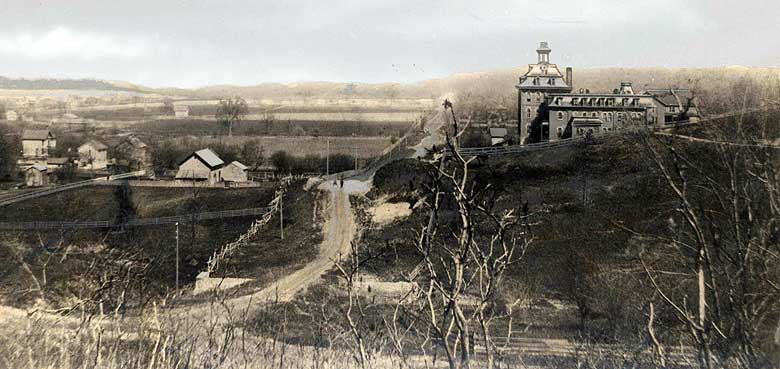Why Rock Island?
(This story was written in celebration of Augustana's sesquicentennial in 2010.)

"Few locations combine, in a more eminent degree, the advantage of accessibility, healthfulness, beautiful surroundings, and quietness for the purpose of study." — 1882-1883 catalog
The location Augustana College and Theological Seminary chose to relocate to in 1875 may need a little explanation when viewing the 1880s image of campus included with this story.
This location was chosen so as to better serve the school's intended population, Swedish Lutheran immigrants.
Looking at the dirt path that was to become 7th Avenue, you may very well ask, "Better than what?" In order to answer the question of why Augustana chose Rock Island, it is helpful to understand why the school's two previous locations were abandoned.
When the Augustana Seminary opened its door on Sept. 1, 1860, that door was to a two-story, wood-framed school-house behind the Immanuel Swedish Lutheran Church in Chicago at the intersection of Wells and Superior streets. Instruction was also given in the basement of the Norwegian church in Chicago. Twenty-one students enrolled the first year (10 Swedish, 10 Norwegian, and one "American"), and enrollment dipped after that.
As early as 1861 efforts were made to find a permanent location for the school, and sites in Wisconsin, Iowa, and Illinois were considered. In 1863 the board of directors purchased land near Paxton, Ill., moved the school there and incorporated under the name Augustana College and Seminary.
Coming from the bustle of Chicago, Paxton was a sleepy town, seemingly off the beaten path to anywhere. The Illinois Central Railway had invited Augustana to examine some of its land holdings near Paxton. The railway later sold the college land well under its value and offered the college a commission for selling other land in Paxton to new settlers.
The "campus" in Paxton eventually consisted of six frame buildings, all serving double duty as classroom space and living quarters for students and faculty. Distractions in Paxton were few; days started at 5 a.m. and students helped with the chores. A literary society that had been formed in 1860 in Chicago provided the Friday night entertainment, with debate, oratory, and music on the agenda.
After less than a decade in Paxton, it became clear that Paxton was not evolving into a mecca for Scandinavian Lutherans, as the wave of Swedish immigrants was moving north into Minnesota, or west into Nebraska and Kansas. Paxton had missed its mark.
The search was on for another location and the charter of the institution was changed to allow the school to move to "any suitable place within the state of Illinois." Geneseo, Ill., had expressed interest in raising money to entice Augustana to relocate, but by 1871 had not raised the funds. The board also allowed the search committee to accept offers of land from Knox, Henry, Rock Island, Bureau, and Cook counties, though such offers never materialized. By 1873, Rock Island was selected as the new home for the now named Augustana College and Theological Seminary.
So, why Rock Island? The Mississippi River was busy with steamer traffic; more than 1,000 steam boats docked in Rock Island in 1870. The first train had reached Rock Island in 1854, and the first train bridge across the Mississippi was completed in 1856, linking Rock Island and Davenport.
The population in Rock Island had skyrocketed from 7,000 in 1852 to nearly 30,000 in 1870. More than 3,500 Scandinavians settled in Rock Island and Moline in the 1870s. Scandinavians were the largest ethnic group in the area, Germans a close second, and those from the British Isles a trifle fewer in third place. This location with both river and rail access was the hub that Paxton could never be.
The site selected for campus was halfway between Moline and Rock Island, where a trolley ran past connecting the towns. The 16-acre plot was secured for $10,000. This "picturesque bluff land," nestled among pastures, orchards, and barns, provided a place remote from town centers but with connections to a metropolitan area and easy access to Augustana for students from the Midwestern Swedish-immigrant communities which Augustana served.
In Rock Island, Augustana would thrive, quickly adding buildings to campus, increasing its enrollment, and graduating the first Augustana College class with a bachelor's degree in 1877. Of those first six college graduates in Rock Island, two were born in Sweden, and the other four were of Swedish parentage, but born in Princeton, Galesburg, and Rockford, Ill., and Sugar Grove, Pa.
Advances in transportation and shifting demographics have changed the face of both Rock Island and Augustana College. The Quad Cities area now boasts a combined population of more than 375,000. Recent graduating classes have numbered in the 500s, representing some 30 states and a dozen countries each year.
Augustana students study the geography and biology of the Mississippi River and its environs, engage in community service in the Quad Cities, and participate in and attend concerts, lectures, and art exhibitions open to the community.
— Jamie Nelson
Special Collections Librarian
